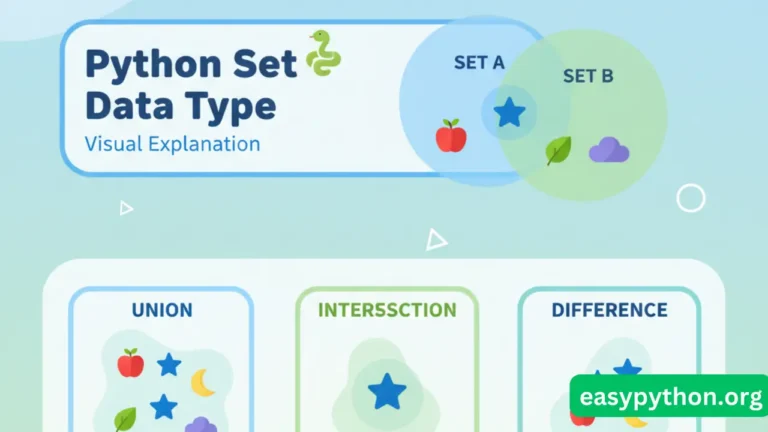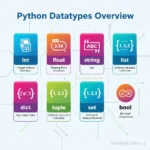Ever tried inviting duplicate guests to a party? 🎉 One guy shows up twice, eats all the biryani, and suddenly the vibes are off. That’s exactly what Python doesn’t allow with sets. A set in Python is like that strict bouncer at the club who checks the guest list and says: “Sorry bro, one entry only.”
But hey, don’t worry — unlike a grumpy bouncer, sets in Python are actually super useful, drama-free, and faster than your friend typing ‘gg’ after losing in Valorant. Today, we’re going deep (but in a fun way) into Python Set Data Types.
Let’s untangle the magic!
What is a Set in Python?
A set in Python is an unordered, mutable collection with no duplicate elements. Think of it as:
- A real-life bucket of unique items (no repeats).
- Perfect for situations where you only care about existence, not order.
- And yes, Python has a frozen cousin too called
frozenset(we’ll get there).
👉 If you’re brand new to Python basics, you might wanna first skim through this Python Data Types overview. Sets are part of that family, right alongside lists, tuples, and dictionaries.
How to Create a Python Set
Creating sets is as easy as saying chai, please.
# Method 1: Using curly braces
my_set = {1, 2, 3, 4}
# Method 2: Using set() function
another_set = set([1, 2, 2, 3, 4]) # duplicates removed!
print(another_set) # Output: {1, 2, 3, 4}⚠️ Warning:{}is an empty dictionary, not an empty set. To make an empty set, useset(). (Yes, Python loves trolling beginners. 😂)
Python Set Properties
Sets have their own little rulebook:
- No duplicates allowed →
{1, 2, 2}magically becomes{1, 2}. - Unordered → The elements don’t care about order; it’s chaos but controlled chaos.
- Mutable → You can add/remove stuff.
- Only hashable elements allowed → You can’t put lists/dicts inside, but tuples are fine.
👉 More on Python’s cousins of collections here: Lists, Tuples, Sets, Dictionaries.
Python Set Methods & Functions
Okay, now the fun part: what can we do with sets?
Adding & Removing Items
numbers = {1, 2, 3}
numbers.add(4) # {1, 2, 3, 4}
numbers.remove(2) # {1, 3, 4}
numbers.discard(10) # no error, unlike remove()Pro tip:remove()throws a tantrum if the element doesn’t exist.discard()is chill — it just ignores.
Set Operations
Sets are basically built for math nerds. You can do:
- Union (
|) → Combines both sets. - Intersection (
&) → Common elements only. - Difference (
-) → What’s in A but not in B. - Symmetric Difference (
^) → Everything except the overlap.
a = {1, 2, 3}
b = {3, 4, 5}
print(a | b) # {1, 2, 3, 4, 5}
print(a & b) # {3}
print(a - b) # {1, 2}
print(a ^ b) # {1, 2, 4, 5}👉 Quick side quest: If this math vibe reminds you of school flashbacks, don’t panic — you’ll use this more often in coding than you ever did in exams.
Python Set Methods Cheat Sheet
| Method | Description | Example |
|---|---|---|
add(x) | Adds an element x to the set. | s.add(10) → {…, 10} |
remove(x) | Removes element x; raises KeyError if not found. | s.remove(5) |
discard(x) | Removes element x if present; no error if not found. | s.discard(99) |
pop() | Removes and returns an arbitrary element (randomly chosen). | s.pop() |
clear() | Removes all elements from the set. | s.clear() → set() |
union(*sets) | Returns union (all unique elements). | s.union(t) |
intersection(*s) | Returns intersection (common elements). | s.intersection(t) |
difference(*s) | Returns difference (items in s not in others). | s.difference(t) |
symmetric_difference(t) | Returns elements in either set but not both. | s.symmetric_difference(t) |
update(*sets) | Updates the set with union of itself & others. | s.update(t) |
intersection_update(*s) | Updates set with intersection. | s.intersection_update(t) |
difference_update(*s) | Updates set with difference. | s.difference_update(t) |
copy() | Returns a shallow copy of the set. | s.copy() |
issubset(t) | Checks if set is a subset of t. | s.issubset(t) |
issuperset(t) | Checks if set is a superset of t. | s.issuperset(t) |
isdisjoint(t) | Checks if sets have no elements in common. | s.isdisjoint(t) |
👉 Pro Tip: Don’t forgetfrozensethas the same methods except the ones that modify (add,remove,discard,update, etc.), because it’s immutable. 🧊
Frozenset: The Frozen Cousin
Python also has frozenset — basically a set that went to Antarctica and froze forever.
frozen = frozenset([1, 2, 3])
# frozen.add(4) ❌ Error (it's immutable)Why would you need it? Because sometimes you want sets to stay constant — like making them keys in a dictionary.
Set Comprehension
Yes, sets have comprehensions just like lists.
squares = {x**2 for x in range(5)}
print(squares) # {0, 1, 4, 9, 16}Clean, short, and very “Pythonic.”
Real-Life Uses of Python Sets
- Remove duplicates from lists
- Membership testing (
if x in my_set) → Super fast! - Data comparison (finding common students, emails, IDs)
- Graph algorithms (nerdy but useful)
Imagine you’re collecting emails from a form, and spammers try entering duplicates — sets save the day automatically.
Common Mistakes Beginners Make
- Thinking
{}is a set (nope, it’s a dict). - Trying to add a list to a set (lists aren’t hashable).
- Expecting order (Python sets are like your messy drawer).
- Using
remove()whendiscard()was safer. - Modifying a set while iterating (just don’t).
👉 Speaking of beginner mistakes, check out this guide on Python Indentation errors — trust me, it’ll save you many headaches.
Extra Resources & Where to Go Next
- Want to learn all Python data types? → Python Data Types Full Overview
- Curious about Python’s built-in functions? → List of Built-ins & Modules
- Totally fresh to Python? → Learn Python for Beginners
- Bookworm? Here’s a great Python books collection
And if you want even more trustworthy reading, the official Python Docs on Sets are always there (but let’s be real — they’re about as fun as reading a washing machine manual).
Final Thoughts
They don’t tolerate duplicates, they don’t care about order, and they’ll give you fast answers when you ask, “Hey, is this thing here?”.
If Python lists are like a shopping list, then sets are like your squad of unique besties. No drama, no clones, just pure efficiency.
So next time you’re coding and need uniqueness, remember: Python Sets have your back. 💪🐍




